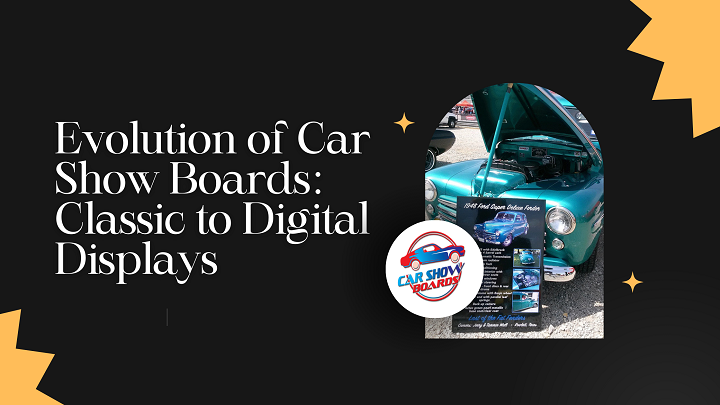
Car shows are a celebration of automotive beauty and innovation, showcasing everything from vintage classics to custom lowriders. A significant part of this experience is the display board—an essential tool for presenting a vehicle’s history, specs, and unique appeal. Over the years, car show display boards have transformed from simple, handwritten signs to sophisticated digital displays, each iteration enhancing the viewer’s experience. This evolution offers car enthusiasts diverse options to showcase their vehicles in ways that capture attention and tell a story. Let’s take a journey through the development of car show boards, from classic designs to modern digital marvels.
Lowrider Car Show Display Ideas in the Early Days
For those with custom lowrider car show display ideas, early car show displays often included unique paint colors, artwork, and customization details. Lowrider owners found creative ways to share these elements, sometimes adding a splash of color or small decorations to stand out from the rest. While the boards were simple, they added a personal touch that reflected each vehicle’s personality and custom features.
A Shift Toward Customization and Creativity
As car shows became more popular, so did the desire for more personalized display boards. Car show enthusiasts began to experiment with materials and layouts. The 1980s and 1990s saw a rise in custom display boards that matched the aesthetic of the vehicles they showcased. Vintage car displays began incorporating retro elements, and lowrider car show display ideas started including intricate designs, matching paint colors, and personalized logos. Display boards became part of the car’s identity, adding to the visual appeal.
These boards were also more detailed, often including background stories, the restoration process, and photos of the car in its original state. Enthusiasts even began using multiple boards or adding accessories like miniature models of their cars to make the display more captivating. This era marked the beginning of car show display boards as more than just informational signs—they became storytelling tools.
Modern Materials for Durability and Aesthetics
Today, car show display boards are not only about aesthetics but also durability. Materials such as acrylic, metal, and high-quality plastics have become popular choices, replacing traditional paper and cardboard. These materials withstand outdoor conditions, making them ideal for all-day events.
For lowrider car show display ideas, modern materials allow for more creative freedom. Using acrylic or metallic boards with custom colors and finishes, car owners can create displays that match or complement their vehicle’s unique design. This approach has added a new dimension to car show displays.
Introducing Digital Displays: Bringing Stories to Life
In recent years, digital displays have taken the car show world by storm. By using LED screens, tablets, and even touchscreen panels, car show display boards have transformed into interactive experiences. Digital displays allow car owners to go beyond static text and images, incorporating videos, interactive car specs, and even soundtracks that match the car’s era or theme.
Benefits of Digital Car Show Display Boards
Digital display boards provide a variety of advantages, such as:
- Flexibility: Owners can update or edit the information at any time, ensuring accurate and relevant content.
- Interactivity: Touchscreen displays let attendees explore the car’s specs, restoration timeline, and unique features.
- Engagement: Videos, animations, and photo galleries bring the car’s story to life, making it more memorable for visitors.
Digital displays work particularly well for lowriders, where owners can showcase their car’s custom hydraulic features, unique paintwork, and other one-of-a-kind elements. For car enthusiasts seeking a cutting-edge presentation, digital boards are the ultimate tool to impress judges and visitors alike.
Combining Classic and Digital for a Unique Display Experience
Some car owners choose to blend traditional and digital elements, creating hybrid car show display signs. This approach combines the tactile appeal of a physical board with the dynamic features of a digital screen. For instance, a classic-style board can showcase the car’s history while an adjacent tablet displays a slideshow or video of the restoration process. This setup offers the best of both worlds, appealing to traditionalists and tech-savvy audiences alike.
Hybrid displays are also ideal for car owners with limited access to electricity at car shows. With a compact battery-operated tablet or LED frame, they can achieve a high-tech look without compromising on the classic appeal of a traditional board.
Creating Your Own Show-Stopping Display
Whether you’re showcasing a vintage classic or a modern lowrider, designing an effective car show display board requires careful thought and creativity. Here are some tips to create an eye-catching display:
- Choose Complementary Colors: Match the board’s colors with your car’s color scheme to create a cohesive look.
- Use High-Quality Materials: Opt for durable materials like acrylic or metal for a polished, long-lasting display.
- Tell a Story: Include engaging details about the car’s history, customization, and unique features that make it stand out.
- Consider a Digital Option: If possible, use a digital board for interactive elements that showcase the car’s unique attributes.
Conclusion
The evolution of car show display boards reflects the innovation and creativity of car enthusiasts worldwide. From classic, hand-painted boards to interactive digital displays, each style offers a unique way to showcase a vehicle’s personality and history. Whether you’re seeking lowrider car show display ideas or designing a board for a classic, there’s never been a better time to get creative. Embrace the trends, choose a style that reflects your vehicle’s character.
Read More: Support Coordination in Sydney: Path to Independence